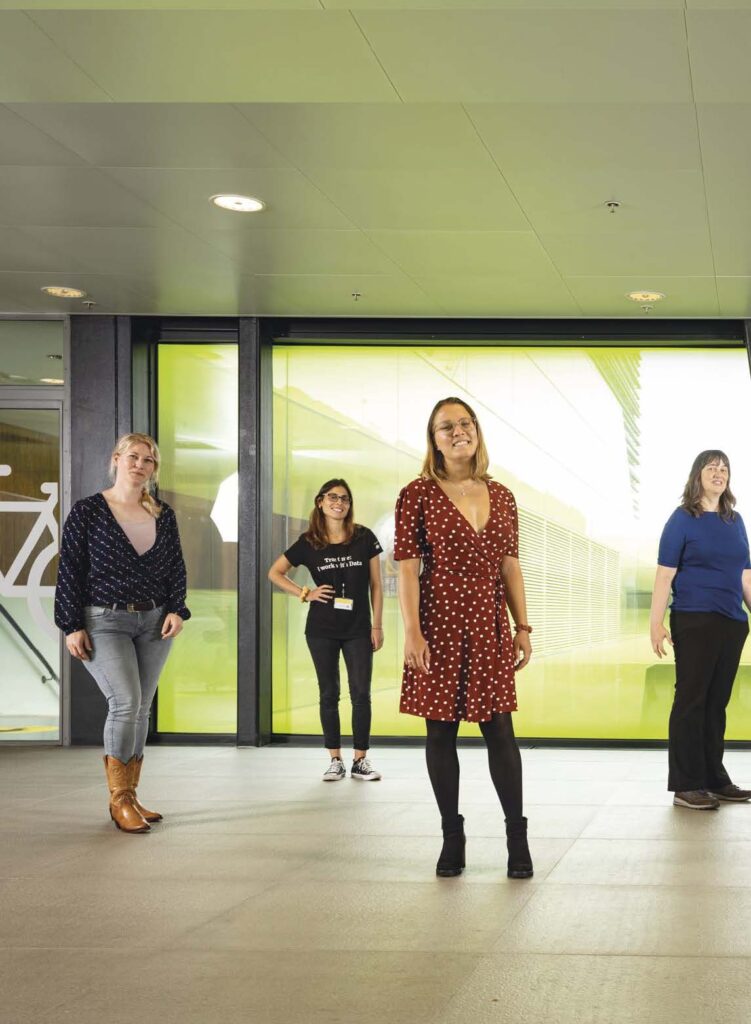Computing that truly improves people’s wellbeing
How can we create intelligent support for online collaborations? How can a sensor-based e-coach prevent us from burning out? These are two examples of questions that the young research group ‘human-centred computing’ at Utrecht University tries to answer.
In June 2018, professor Judith Masthoff started a new research group at Utrecht University: human-centred computing. The core idea is that the success of computing does not just depend on the technology itself, but also — and sometimes even more so — on the interaction with the user.
The field of human-computer-interaction (HCI) was already investigated in the 1960s by computer pioneers such as Douglas Engelbart (inventor of the computer mouse) and Joseph Licklider (pioneer of interactive computing). Masthoff’s group exploits both the miniaturisation and increasing power of computing hardware and recent advances in artificial intelligence to develop future HCI and human-centred artificial intelligence (AI). ‘My dream is that computing truly improves people’s wellbeing’, Masthoff says. ‘My research group is interested in both computing and humans. Our computing research is always inspired by what people do, what they want, what is good for them and what they think of the technology. How can interactive computing and AI be used to persuade passengers to spread more evenly over the day in public transport? How can it help create more efficient teams in online collaborations? How can autonomous systems explain their decisions? This is the type of questions that we investigate.’
To study such questions, the researchers in Masthoff’s group combine an interest in computer science, especially AI, with an interest in social sciences, especially psychology.
Masthoff’s group had just set up two laboratories when the corona crisis broke out. ‘One lab had just been commissioned, but it was not yet at the proper location. We call that lab the Ideation & Creation lab. Here people can be creative, generate new ideas and immediately start prototyping them. It is equipped with things like 3D-printers, soldering equipment, sensors and other electronics. Another lab is a Reconfigurable area for user studies. There we perform studies that involve users. We can do things like eye-tracking, video-recording user behaviour, and measuring how users feel. We also have a Pepper-robot and some other, smaller robots to study human-robot interaction.’
One of the most technical members of the human-centred computing group is assistant professor Egon van den Broek. He studies pattern recognition in both humans and machines. ‘There is an awful lot that machines can still learn from humans’, he says. ‘I take the human as an example, and based on this, I develop mathematical models that can improve the way machines recognise patterns. For example, I have been looking at categorising colours and at recognising emotions. One of my favourite results is from earlier this year: we showed that emotions should be classified more as a continuous space than as separate categories, as it is traditionally done. Our results can be used in human-robot interaction where the robot has to recognise human emotions.’
Van den Broek earned two PhD degrees, one in the social sciences and one in electrical engineering, mathematics and computing science, a combination which fits perfectly in the human-centred computing group. ‘I like the fact that there is a lot of energy in the group, that it combines a wide range of interests and that it is very social. What remains a challenge in the field of human-computer interaction in general, and also in our group, is to work not just in a multi-disciplinary way — people with different backgrounds sitting next to each other — but in a truly interdisciplinary way — to integrate methods from various disciplines. That is crucial if the field is to become mature.’
Ioanna Lykourentzou is another assistant professor in the group. She investigates online collaborations and develops software to improve them. ‘Because of the corona crisis, my work has suddenly become even more relevant than before’, she tells. ‘Many people have to work from home, while at the same time collaborating in online teams. But how can you build the best team if there are team members you have never met in real life?’
To solve this problem, she has already built an algorithm that matches people based on their personality traits. Lykourentzou: ‘For complex tasks, you often need people with a variety of skills: some people should have leadership qualities; others should excel at focusing on details, while others need to have good social skills. In its core, this is an optimisation problem, which at the same time needs to consider human nature. Our algorithm matches people with people to form the best team. We tested it with teams of crowd workers who had to create an advertisement for a new coffee product and it proved to work really well. With this approach, digital collaborations can become very creative.’
As somebody developing tools to improve collaboration, what does she think about the teamwork in her own human-centred computing group? ‘I like the diversity in the group, and the fact that things come about in a very human manner without an imposed hierarchy. Sometimes, taking decisions might take a bit longer than in more hierarchical groups, but in the end you have a much stronger team.’
Group passport
Research field
- Human-centred computing: human-robot interaction; mobile and wearable computing; personalised, adaptive, and recommender systems; affective and empathic computing; persuasive technology, e-coaching, and serious games; computer-supported collaborative work and crowd computing; interactive data analytics.
Institution
- Utrecht University
Employees (as of September 2020):
- 1 professor, 9 assistant professors, 14 PhD students
Facilities
- Ideation & Creation space; reconfigurable area for user studies
Website
Published in I/O Magazine #2 2020
Text Bennie Mols
Images Ivar Pel
